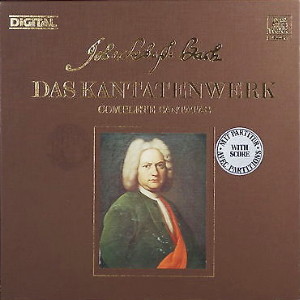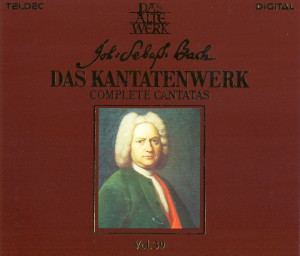 |
|
2 LPs
- 6.35658 EX - (p) 1987
|
 |
| 2 CDs -
8.35658 ZL - (p) 1987 |
|
| DAS KANTATENWERK - Volume 39 |
|
|
|
|
|
|
|
| Johann Sebastian
BACH (1685-1750) |
Kantate
"Ihr, die ihr euch von Christo nennet",
BWV 164
|
|
17' 25" |
|
|
Am
13. Sonntag nach Trinitatis (Dominica 13
post Trinitatis)
|
|
|
|
|
Text:
Salomo Franck, 1715 (1-5); Elisabeth
Creuziger, 1524 (6) |
|
|
|
|
Solo:
Sopran, Alt, Tenor, Baß - Chor; Flauto
traverso I/II; Oboe; Streicher; Basso
continuo (Violoncello, Violone, Organo)
|
|
|
|
|
- 1.
[Aria] (Tenore): "Ihr, die ihr euch von
Christo nennet" |
4' 28" |
|
A1 |
|
- 2.
Recitativo (Basso): "Wir hören zwar, was
selbst die Liebe spricht" |
1' 47" |
|
A2 |
|
- 3.
Aria (Alto): "Nur durch Lieb und durch
Erbarmen" |
4' 34" |
|
A3 |
|
- 4.
Recitativo (Tenore): "Ach, schmelze doch
durch deinen Liebesstrahl" |
1' 42" |
|
A4 |
|
- 5.
Aria (Duetto) (Soprano, Basso): "Händen,
die sich nicht verschließen" |
3' 58" |
|
A5 |
|
- 6.
Choral (Coro): "Ertöt uns durch dein Güte"
|
0' 57" |
|
A6 |
|
|
|
|
|
|
Kantate
"O heilges Geist- und Wasserbad",
BWV 165 |
|
12' 26" |
|
|
Am
Trinitatisfest (Festo Trinitatis)
|
|
|
|
|
Text:
Salomo Franck 1715 (1-5); Ludwig Helmbold,
1575 (6) |
|
|
|
|
Solo:
Sopran, Alt, Tenor, Baß - Chor; Fagotto;
Streicher; Basso continuo (Violoncello,
Violone, Organo) |
|
|
|
|
- 1.
[Aria] (Soprano): "O heilges Geist- und
Wasserbad" |
3' 08" |
|
A7 |
|
- 2.
Recitativo (Basso): "Die sündige Geburt
verdammter Adamserben" |
1' 26" |
|
A8 |
|
- 3.
Aria (Alto): "Jesu, der aus großer Liebe" |
2' 20" |
|
A9 |
|
- 4.
Recitativo (Basso): "Ich habe ja, mein
Seelenbräutigam" |
2' 04" |
|
A10 |
|
- 5.
Aria (Tenore): "Jesu, meines Todes Tod" |
2' 57" |
|
A11 |
|
- 6.
Choral (Coro): "Sein Wort, sein Tauf, sein
Nachtmahl" |
0' 36" |
|
A12 |
|
|
|
|
|
|
Kantate
"Wo gehest du hin?", BWV 166 |
|
17' 50" |
|
|
Am
Sonntag Cantata (Dominica Cantate) |
|
|
|
|
Text:
Anon. (2,4,5); Johannes 16,5 (1);
Bartholomäus Ringwaldt, 1582 (3); Ämilie
Juliane von Schwarzburg-Rudolstadt, 1686
(6) |
|
|
|
|
Solo:
Alt, Tenor, Baß - Chor; Oboe; Streicher;
Basso continuo (Violoncello, Violone,
Organo) |
|
|
|
|
- 1.
Aria (Basso): "Wo gehest du hin?" |
1' 59" |
|
B1 |
|
- 2.
Aria (Tenore): "Ich will an den Himmel
denken" |
7' 25" |
|
B2 |
|
- 3.
Choral (Soprano): "Ich bitte dich, Herr
Jesu Christ" |
2' 53" |
|
B3 |
|
- 4.
Recitativo (Basso): "Gleichwie die
Regenwasser bald verfließen" |
0' 55" |
|
B4 |
|
- 5.
Aria (Alto): "Mann nehme sich in acht" |
3' 49" |
|
B5 |
|
- 6.
Choral (Coro): "Wer weiß, wie nahe mir
mein Ende" |
0' 52" |
|
B6 |
|
|
|
|
|
Christoph
Wegmann (Solist des Tölzer
Knabenchor), Sopran (BWV 164, 166)
Tobias Eiwanger (Solist des Tölzer
Knabenchor), Sopran (BWV 165)
Paul Esswood, Alt
Kurt Equiluz, Tenor
Max van Egmond, Baß
Tölzer Knabenchor |
Gerhard Schmidt-Gaden, Leitung
Collegium Vocale Gent | Philippe
Herreweghe, Leitung
LEONHARDT-CONSORT mit
Originalinstrumenten
- Walter van Huwe, Ricardo Kanji, Flauto
traverso
- Frans Berkhout (BWV 165), Fagotto
- Ku Ebbinge, Oboe
- Marie Leonhardt, Lucy van
Dael (solo BWV 166/2), Alda Stuurop, Alda
Stuurop, Mariet Holtrop, Antoinette van den
Hombergh, Marinette Drost, Violinen
- Staas Swiestra, Ruth Hesseling, Viola
- Frans Berkhout, Fagott
- Wouter Möller, Richte van der Meer, Violoncello
- Nicholas Pap, Violone
- Gustav Leonhardt (BWV 164/2,3; 165/3,2;
166/2,4), Bob van Asperen (BWV 164/1,4;
165/1,4,5; 166/1,5), Glenn Wilson (BWV
164/5,6; 165/6: 166/3,6), Organo
Gustav Leonhardt, Gesamtleitung
|
|
|
|
|
Luogo
e data di registrazione |
|
(luogo e data di
registrazione non indicati)
|
|
|
Registrazione: live
/ studio |
|
studio |
|
|
Producer |
|
Wolf Erichson
|
|
|
Prima Edizione LP |
|
Teldec "Das Alte
Werk" | 6.35658 EX | 2 LPs -
durata 48' 26" - 55' 02" | (p)
1987 | DIGITAL DMM
|
|
|
Edizione CD |
|
Teldec Classics |
LC 6706 | 8.35658 ZL | 2 CDs -
durata 48' 26" - 55' 02" | (p)
1987 | DDD |
|
|
Cover
|
|
Johann Sebastian
Nach, einige Jahre vor seiner
Ernennung zum Kantor in Leipzig.
Gemälde con JJ. Ihle (1720) Bach
Museum Eisenach.
|
|
|
Note |
|
In questo volume sono
presenti anche La Cantate BWV 167,
BWV 168 e BWV 169 a cura del
Concentus Musicus Wien diretto da
Nikolaus Harnoncourt.
|
|
|
|
|
INTRODUCTION
by Gerhard Schuhmacher
"Ihr, die ihr euch von
Christo nennet" (BWV 164)
based on a poem in Salomo
Franck’s collection of
cantata texts Evangelisches
Andachts-Opffer published in
1715, was composed in
Leipzig for August 16, 1725.
It deals with the Imitatio
Christi, which is
illustrated by the use of
imitative counterpoint. This
is matched by an
appropriately strong element
of chamber music in the
work. In the opening aria
the vocal line is integrated
into the rich string
texture, the key being
confirmed by a powerful leap
of a fifth.
All the more effective is
the inversion of the subject
at the words ”Wo bleibet die
Barmherzigkeit?... Sie ist
von euch, ach, allzuweit”
(Where is that mercy now
revealed?... From you 'tis
fled, ah far afield); they
relate to the melisma on the
Word ”Barmherzigkeit” in the
recitative (No. 2) which, by
describing the Priest and
the Levite as pitiless
Christians, alludes to the
parable of the Good
Samaritan. In the alto aria
”Nur durch Lieb und durch
Erbarmen” (By our love and
tender mercy) the concept of
the Imitation of Christ is
expressed by two flutes,
Bach’s favoutite instrument
for this idea. After the
emphasis placed on pity in
No. 2, love is the focal
point in the accompanied
rocitative No. 4. Arioso
elements prepare the way for
the expressive duet for
soprano and bass in movement
No. 5, accompanied by
strings and winds. This
movement, another canon,
reverts to the basic concept
ofthe opening aria, thereby
creating a strong musical
link throughout the cantata,
which is rounded off by a
simple four-part chorale.
"O heilges Geist- und
Wasserbad" (BWV 165)
was probably composed in
Weimar for Trinity Sunday,
1715, and may have been
performed again with slight
changes on Trinity Sunday of
1724 in Leipzig; the
reservations arise from the
nature of the source
material. The text is once
again from Salomo Franck's
collection of 1715 (cf. BWV
164). The opening aria is a
striking example of the
freedom with which Bach
treated forms and expressive
values. Its structure is
that of a fugue, its form a
rondo; some of its sections
contain free inversions of
the basic theme. The string
figures and the formal
arrangement contribute to a
symbolic interpretation of
the text, e.g. the inversion
at the words "O Flut, die
alle Missetat
ertränket und uns das neue
Leben schenket” (O Fount,
which swallows sin and
pride, ...our strength and
hope and life renewing). No.
2, a recitative with arioso
declamation on certain words
characteristic of the Weimar
cantatas, and No. 3, a
moving, prazer-like alto
aria with continuo, refer to
Man's redemption through
baptism. An expressive
accompanied recitative, No.
4, containing arioso
passages which are so free
as to be almost
improvisations, introduces a
tenor aria ("Jesu, meines
Todes Tod"), in which the
violins and violas in unison
powerfully support the
salvation of those who are
baptised and turn to Christ.
The string figures are
inspired by the
"Heilschlänglein" (the snake
of salvation), in contrast
to the venomous snake in the
Garden of Paradise. The
words of the final chorale
"sein Wort, sein Tauf, sein
Nachtmahl" (Thy Word,
communion, sacrament) are
closely linked to Franck's
original text.
"Wo gehest du hin?" (BWV
166) was written in
Leipzig for May 7, 1724, the
Fourth Sunday after Faster,
to the words of an unknown
author. In the first
movement, a cross between an
aria and an arioso, the bass
with string accompaniment is
clearly intended to be the
voice of Christ; this is
also obvious from the
following movements. The
words “Where goest Thou
Lord, ah where?" are set
with expressive figures
illustrating both the
question and the idea of
going; the word "where" is
used repetitively and the
interrogative motif also
dominates the instrumental
writing. For the following
aria ”lch will an den Himmel
denken” (All my thoughts to
Heav’n are turning) the solo
violin pail has been
reconstructed. Although a
violin and obbligato oboe in
a cantata aria is
comparatively rare, it is
implied by the whole
substance of the work in
which the emotive content of
the second and third
movements is provided by
Heaven, that of the fourth
and fifth by the World.
Mutual imitation by the
oboe, symbol of heaven, and
the violin, symbol of Man
turning to God, is enhanced
by the text ”Ich will an den
Himmel denken” (All my
thoughts to Heav’n are
turning); the melisma on
”schenken" (give) emphasises
the word, even though it is
negated. This also applies
to the fifth movement, in
which worldly pleasures
determine the emotional
content, though they too are
renounced. It is a fact of
life in baroque music that
the sentiments of ideas and
concepts are not impaired by
being expressed in musically
contradictory terms. The
contrast between Heaven and
the World reinforces the
intention of the movement.
The tenor aria is followed
by a chorale concerto, the
seriousness of which is
emphasized by the long note
values; the violins and
violas, playing in unison,
syrnbolise the concept of
Man turning to God, just as
they do in the fifth
movement of Cantata No. 165.
The cantata ends with the
chorale ”Wer weliß, wie nahe
mir mein Ende” (Who knows
how near is my last hour),
which is as powerful as the
opening aria and the chorale
concerto in the middle of
the work.
|
  |
|
|